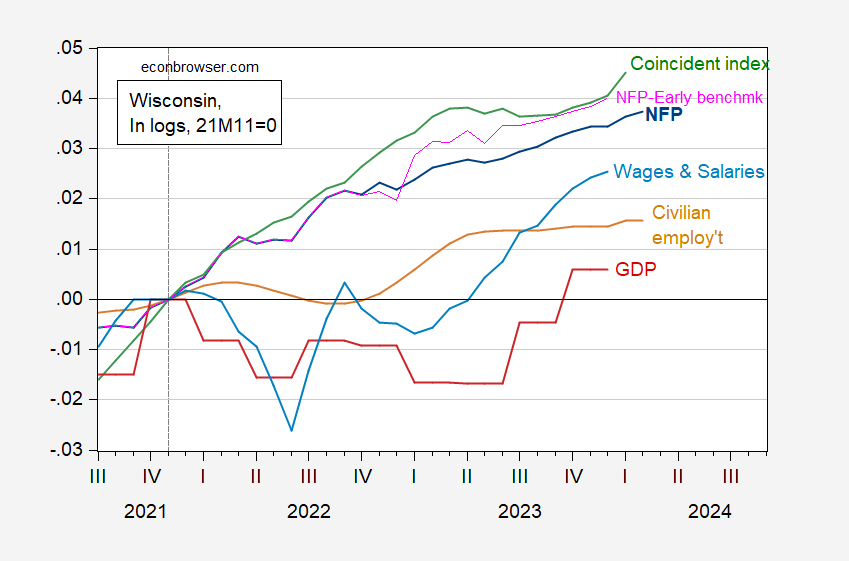From BEA state level data released on Friday. GDP grows 4.2% SAAR, Chained CPI deflated wages and salaries by 1.9%; Year-on-Year, 1.5% and 3.0% respectively. While NFP only grew 0.9% q/q AR, the Philadelphia Fed’s early benchmark measure of NFP grew 1.5%.
Figure 1: Wisconsin Nonfarm Payroll Employment (dark blue), Philadelphia Fed early benchmark measure of NFP (pink), Civilian Employment (tan), real wages and salaries linearly interpolated, deflated by national chained CPI (sky blue), GDP (red), coincident index (green), all in logs 2021M11=0. Source: BLS, BEA, Philadelphia Fed [1], [2], and author’s calculations.
In January, the Coincident Index surged 2.9% q/q AR. NFP employment appeared to have continued momentum, with February q/q AR growth at 1.2%. While civilian employment only grew a corresponding 0.4%, it’s important to recall the household survey series are subject to much greater imprecision, particularly at the state level [1].
In my view, the assertion by the WisGOP in response to Governor Evers’ State of the State address that Wisconsin is undergoing a recession is unjustified.

Off topic – more war:
One of the worries arising from Russia’s two invasions of Ukraine is that the post-WWII era of peace between European countries could be at an end. “European” is not quite the right geography here, but there is increasing talk of war between Azerbaijan and Armenia.
Remember how Russia decided that Ukraine doesn’t have the sovereign right to choose its own friends, and invaded – twice? Well, Armenia seems to be choosing some new friends, too:
https://www.politico.eu/article/eu-armenia-azerbaijan-crisis-ursula-von-der-leyen-antony-blinken-war-fears/
Central to Armenia’s interest in new alliances is Russia’s refusal to intervene last year when Azerbaijan grabbed the disputed region of Nagorno-Karabakh from Armenia by force.
The concern, for now, is not that Russia will treat Armenia as it has Ukraine, by invading. Rather, there is growing concern about war breaking out between Azerbaijan and Armenia, with Russia backing Azerbaijan and Armenia angling for western support.
There are other Armenian territories in which Azerbaijan reportedly has an interest:
https://www.orfonline.org/research/the-fall-of-nagorno-karabakh-and-its-impact
Note the Turkish interest mentioned in the link.
War in Ukraine. War in Palestine, which is one among 45 armed conflicts in the Mid-East and North Africa. The threat of war among former Soviet Republics. The threat of war in the South China Sea. Is there something new going on?
The overall trend in deaths from armed conflict had been downward since WWII, though with a great deal of variability. However, since around 2005, we may be experiencing a change in trend:
https://ourworldindata.org/war-and-peace?insight=conflict-deaths-have-declined-it-is-on-us-that-this-trend-continues#key-insights
Deaths in armed conflict in 2022 were the highest since 1986, and 2023 seems likely to top 2022. Great for arms makers. Bad for everyone else.
Readers of this blog have been less exposed to “China GOOD, U.S.BAD!” style propaganda since ltr stopped commenting, but we all knew that wasn’t the end of it, right?:
https://www.nytimes.com/2024/04/01/business/media/china-online-disinformation-us-election.html